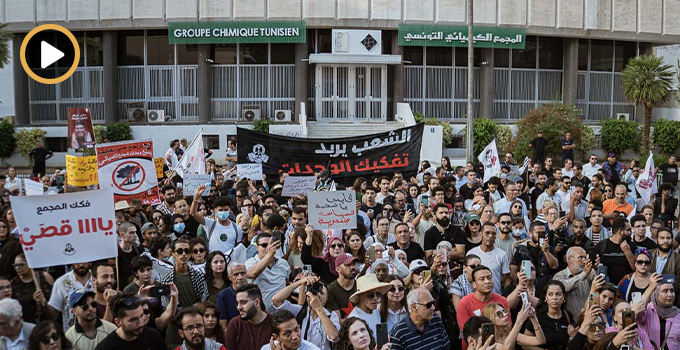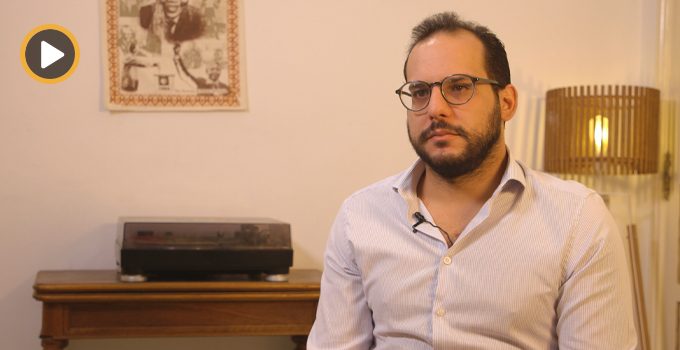Tunisia’s Water Heritage
The merit of Ifrîqiya is to have developed this system by building impressive hydraulic installations, unique in the Mediterranean world. The prototype of the Aghlabid basin spread across Ifrîqiya, a geographical range from Tunis in the north to Gafsa in the south. It took on various forms. The most famous is the basin of the al-Bahr palace in Raqqada. Rectangular in form, it was built in 905 by the Aghlabid prince Ziyâdat Allâh III. This rainwater collection system was maintained in Tunisia until contemporary times. The Aghlabid Basins, Qantara: Mediterranean Heritage
Qanats/Foggaras/M’koulas/Water Tunnels
Source: “Qanat,” Wikipedia.
Browsing abundant research projects, studies, and resources produced during a peak in interest and efforts (over the past fifteen years or so) to document and safeguard the “water heritage” of the Mediterannean basin, one finds modest estimations of the potential bearing that ancient water systems might have on modern hydraulic systems. In Tunisia, ancient sites bearing what are alternatively called qanats, foggaras, or m’koulas such as the Aghlabid basin in Kairouan, the El Guettar oasis outside of Gafsa, and the Mansour water tunnels became the focus of studies like the Foggara Research Project (2003-2006). An introductory project report published by the Traditional Knowledge Research Center (IPOGEA) stated that
The United Nations and other organizations are encouraging the revitalization of traditional water harvesting and supply technologies in arid areas to foster the sustainable use of water resources. They safeguard the environment; they make a sustainable use of resources and produce water better than by means of conventional technologies. Foggara is not one simple technological solution but rather an elaborated system including know-how, social organization and management systems. According to UNESCO well-documented study-cases can provide excellent guidelines to policy making and new project design. The research on foggaras will provide a pattern to improve the quality of life of individuals or groups living in countries affected by desertification or social alienation. Anna Cirella, Foggara Project Incomed – IPOGEA; Water Cultural Heritage: A Dimension of Participatory Approach in the Mediterranean
Institutions and universities in Italy, Spain, Algeria, Morocco, and Tunisia participated in the project carried out in the scope of combatting desertification and promoting cultural heritage. The Institut des Régions Arides (IRA) – Médenine, established by law n°76/6 of 7 January 1976 within the Ministry of Agriculture, was the agency responsible for conducting research and groundwork in Tunisia over the designated 36-month period. In January 2009, Bellachheb Chahbani and Mohamed Moussa co-authored a report on The “Qanat” (foggara) systems in Tunisia that described the methodology and preliminary results of its studies for the project, the latter including:
– the analysis of the mean causes of the abandon of The “Qanat” (foggara) systems in Tunisia;
– recommendations for the rehabilitation of the “Qanat” (foggara) systems in Tunisia, with the consideration of the system as a cultural heritage which could be used for the tourism development:
– proposal of new techniques to improve water mobilization and uses (irrigation) of the “Qanat” (foggara) systems which are still working in Tunisia.
Most of the information gathered and documented over the years on Tunisia’s water heritage can be attributed to the IRA – Médenine, which more recently completed a collaborative research project with the University of Valencia. A brief report in 2011 detailed the investigation’s key researchers and funding sources:
The ESTEPA research group, from the Geography Department of the University of Valencia, Spain, and the “Institute des regions arides de Medenine” (Arid regions Institute of Medenine) of Tunisia, are carrying out a project called “Centro de Estudios Mediterráneos de Galerías de Agua, CEMGA” (Center of Mediterranean Studies of Drainage Tunnels) aimed to catalogue the existing draining galleries in Tunisia. This project is supported financially for a period of four years (2010-2013) by the Integrated Action of the Spanish Agency of International Cooperation for Development (AECID). Miguel Antequera, et al., Inventory, Analysis, Valorisation and Restoration of a Singular Water Heritage: Drainage Tunnels (“M’koulas”) of Tunisia
Through “the inventory, cataloging, heritage and environmental evaluation” of tunnels in Kebili, Tozeur, Gafsa, and Gabes, the research team created a bibliography of 89 water tunnels. It was at this stage of investigation that the value of Tunisia’s water tunnels was determined to be of a historical and cultural worth, and the potential for functionality was dismissed: “Through this research we are able to diagnose the present condition of the drainage tunnels in the south of Tunisia and at the same time to elaborate proposals for increasing their value as a heritage, not to the extent of its operational use, but related to their associated landscape and heritage resources.”
Present discussions relating to the water crisis1 in Tunisia (note Marzouki’s ill-received water crisis premonitions) and reports over the past several months on the water cut in Kairouan prompted Nawaat’s inquiries for Mr. Mohamed Moussa of the IRA. Responding to our inquiry regarding Kairouan’s current water woes, Mr. Moussa explained that,
According to the work carried out, which covered the entire country, the majority of tunnels will have a patrimonial and touristic value if they are restored and maintained since the groundwater level has been greatly reduced by the creation of deep wells and the obstruction of certain tunnels as a result of the ignorance of their value … In the region of Kairouan, we have worked primarily on the Nasrallah tunnel and others that carried water into the city of Kairouan. In arid and semi-arid regions, the tunnels cannot resolve the problem of water supply!!!! Mohamed Moussa in response to Nawaat’s questions
‘This Region is Suffering From Thirst—And May Perish By It’2
The story of Kairouan is a story of water; a precious commodity of rare strategic value in an arid and hostile environment from the earliest ages, water was a determining factor in the selection of the site upon which, in the 7th century, was established the city of the Arab conqueror Okba. Faouzi Mahfoudh et al., The Story of Water and Hydraulic Installations in the Basin of Kairouan
A Google Web search on «l’eau + Kairouan» produces a disconcerting variety of reports on the magnificent Aghlabid basins, the conqueror Okba’s recovery of a lost golden cup («When picking the cup up, water sprang from the ground»), and the stoppage of running water to the Haffouz delegation of Kairouan, so that one is left confusedly marveling at the graceful aesthetic and functional design of the region’s ancient water source and wondering how residents of such parched lands have survived the summer months without the potable running water to which they are accustomed.
Takrawan, an online news journal out of Kairouan, reported in July on a protest in which residents of El Alia in the delegation of Haffouz, indicated that, after three months of without running water, their supplications to local authorities bore promises for intervention and no results. Iterating that the region is equipped with adequate water supply infrastructure, citizens and supporters from the Tunisian Forum for Economic and Social Rights have appealed to the governor to intervene and provide an alternative, independent water source unencumbered by the possibility of being affected by cuts in neighboring regions.
On a trip to El Alia last week, Nawaat found the village still without running water, living conditions deteriorated, residents pleading the same cause after six months. Old and young, women and men displayed messages of «No to marginalization,» «We want equality amongst regions,» and «Save us from thirst and death.» Accounts of contaminated water (from a nearby lake where people have taken to quench their thirst), illness, lack of cleanliness and personal hygiene, the burden on agricultural activities convey the extent to which daily routine has been disrupted and quality of life diminished in El Alia. According official statistics, 175 out of 312 schools in the region are currently without running water, and even the water that is brought is unclean.
Mohsen Kalbousi of Tunisian Forum for Economic and Social Rights explained that the source of cut is in fact an electricity cut in the water pump engine, a fact that may explain the lack of initiative to resolve the issue. Indeed, such a problem would indicate that those responsible for taking action are the National Water Distribution Utility, SONEDE, affiliated with the Ministry of Agriculture, the Tunisian Electricity and Gas Company, STEG, affiliated with the Ministry of Industry, Energy, and Mines, as well as the local government officials representing the region and its residents. That Kairouan’s case is neither the gravest of its kind nor by any means singular in wanting for the attention of responsive authorities is at once a question of resource management and regional governance, and an ironic, drastic deviation from the region’s impressive water heritage.
Last month, a World Bank «Feature Story» on Water: Tunisia’s Other Development Challenge described the institution’s financial support and groundwork assistance in the country: «The World Bank has supported Tunisian efforts to meet its water challenges with projects to upgrade the distribution infrastructure, rationalize use and better manage resources.» Among three distinct water programs, the Second Water Sector Investment Project would appear a potential catalyst for improving water infrastructure/management in underserved areas.
Specifically, project plans for Kairouan appear pertinent to address «General water, sanitation and flood protection sector; Wastewater Treatment and Disposal; Water supply; Irrigation and drainage; Public administration- Water, sanitation and flood protection» in the region, as designated by a 2013 Procurement Plan. The Plan itself being sufficiently technical and bare-boned, Nawaat has contacted the World Bank to the end of understanding in more detail project plans and progress in Kairouan, although we have yet to receive any clarification or information.
Qanats, foggaras, m’koulas…these ancient structures that once bore water for human activity, land use, development…appear now in juxtaposition to Tunisia’s present physical and political capacity to manage water supply and distribution. Citizens’ plea to be saved «from thirst and death» is a shameful indication that time has passed and conditions have deteriorated far beyond what might be reasonably justified by the institutions responsible—in this case, SONEDE, STEG and the local branch of government. And, unfortunately, decades of selective governance and preferential treatment amongst (especially the country’s coastal versus interior) regions, plus the present political turbulence and uncertainty that marks the countdown to elections do not bode well for any immediate, sustainable resolutions for the residents of El Alia and many others whose stories we hope to share in the near future.
Notes
1. Note in particular Nour El Houda Chaabane’s article on Water in Tunisia: A Hidden Crisis! Chaabane writes, ” ‘Water in Tunisia is scarce. But until now, we have managed our resources well, and so we cannot speak of a water crisis,’ confirms Abderrazak Souissi, university teacher and General Director of the Office of Hydraulic Planning and Equilibrium within the Ministry of Agriculture. According to Meriem Labyadh, geology teacher at the Faculté des Sciences in Bizerte, the water crisis in Tunisia exists since long ago and will always exist because everything depends upon the climate: ‘If there is rainfall, we don’t have problems; if there is not, we are indeed looking at a water crisis.’ »
2. This Region Is Suffering From Thirst, and May Perish By It, La Rédaction, Nawaat. 26 September 2014.






iThere are no comments
Add yours